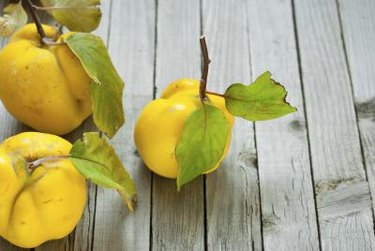
Quince trees produce a golden, aromatic fruit known by the scientific name Cydonia oblonga. In Western Asia and tropical countries, quince is soft and juicy, though in North America quince has a tougher rind and astringent flesh. Cook quince before you eat it to make it more palatable, if you live in colder climates. Choose large, firm quinces with little or no green coloring and handle them carefully because they bruise easily.
Jellied
Video of the Day
Quince has a high pectin content, so is popular in jams and jellies. Pectin is a type of carbohydrate that produces structure and stiffness in jelly via chemical interactions with acidic substances and sugar. Make quince jelly by slicing raw, unpeeled quinces and simmering for 25 minutes. Strain the juices and boil them with sugar and lemon juice. Remove the jelly from heat when it thickens and clings to a spoon. Skim off the foam and use the jelly or can it for later use.
Video of the Day
Baked
Bake quinces and eat them as a warm, comforting snack, or serve over ice cream or angel food cake for dessert. Preheat your oven to 300 degrees Fahrenheit. Core, quarter and peel away any tough areas on your quinces. Overlap the slices in a baking dish, then drizzle them with honey and sprinkle with citrus juice and water. Use lemon, lime, apple or orange juice, depending on your preferences. Cover and bake for one hour or until the slices become translucent. Remove the covering and bake an additional 10 minutes to thicken the juices.
Poached
Quarter and peel quinces before poaching, or boiling. Mix together water, a sweetener and citrus juice in a large pot. Use seven cups of water and one cup of sweetener for 6 to 8 quinces, for example. Do not use artificial sweeteners, but try honey, agave syrup or raw sugar. Add vanilla bean, if you prefer, or use other spices. Simmer quinces in the water until you can easily pierce them with a sharp knife, about one to two hours, depending on size.
Membrillo
Prepare membrillo, also known as quince paste, by poaching with lemon and 1 vanilla bean per 4 to 5 quinces. Wash and remove quince fuzz before poaching, but keep the skin. After poaching, reserve the liquids and set the quince quarters aside. Puree the quince using a blender or food processor. Mix the quince puree with equal amounts of sugar and 1 tsp. of lemon juice per cup of quince. Return to heat and simmer for two to three more hours, or until the quince thickens into a paste. Eat in moderation due to the high sugar content.
Raw
Eat quince if you live in a tropical climate. In hotter countries, the wooly rind of quince disappears and the fruit becomes softer and less acidic. Avoid raw quince from colder climates because of tannin chemicals, which taste unpleasant and disrupt digestion. One plain quince has 50 calories from carbohydrates, 2 g of fiber, 25 percent of your daily requirement of vitamin C and small amounts of iron and calcium.
- Centers for Disease Control and Prevention; Fruit of the Month; Quince
- Alaska Science Forum; On the Jelling of Jellies; Sue Ann Bowling; Aug. 22, 1988
- National Center for Home Food Preservation; Making Jams and Jellies; June 2005
- David Lebovitz; Rosy Poached Quince; David Lebovitz; November 2008
- Always Order Dessert; How to Make Home Made Membrillo (Quince Paste); Alejandra Ramos; November 2008